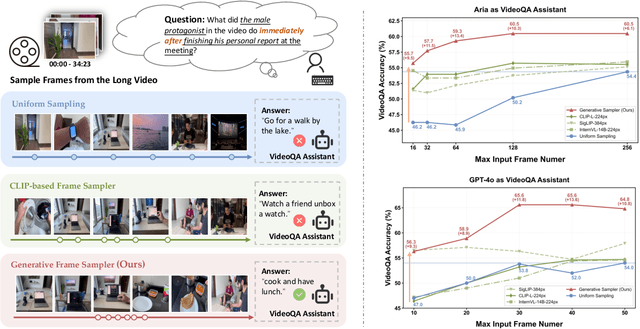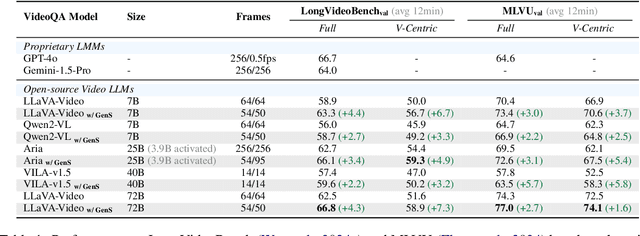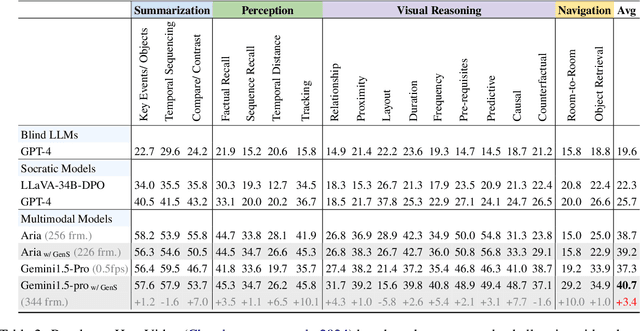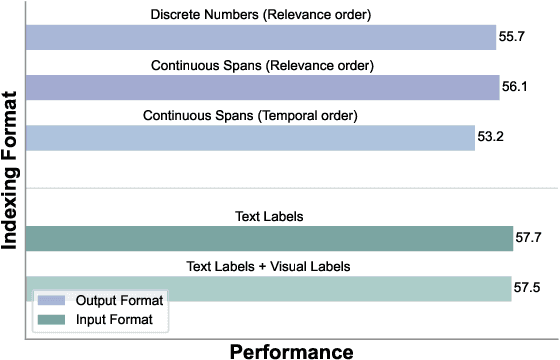Haoning Wu
VQualA 2025 Challenge on Visual Quality Comparison for Large Multimodal Models: Methods and Results
Sep 11, 2025Abstract:This paper presents a summary of the VQualA 2025 Challenge on Visual Quality Comparison for Large Multimodal Models (LMMs), hosted as part of the ICCV 2025 Workshop on Visual Quality Assessment. The challenge aims to evaluate and enhance the ability of state-of-the-art LMMs to perform open-ended and detailed reasoning about visual quality differences across multiple images. To this end, the competition introduces a novel benchmark comprising thousands of coarse-to-fine grained visual quality comparison tasks, spanning single images, pairs, and multi-image groups. Each task requires models to provide accurate quality judgments. The competition emphasizes holistic evaluation protocols, including 2AFC-based binary preference and multi-choice questions (MCQs). Around 100 participants submitted entries, with five models demonstrating the emerging capabilities of instruction-tuned LMMs on quality assessment. This challenge marks a significant step toward open-domain visual quality reasoning and comparison and serves as a catalyst for future research on interpretable and human-aligned quality evaluation systems.
VideoReasonBench: Can MLLMs Perform Vision-Centric Complex Video Reasoning?
May 29, 2025Abstract:Recent studies have shown that long chain-of-thought (CoT) reasoning can significantly enhance the performance of large language models (LLMs) on complex tasks. However, this benefit is yet to be demonstrated in the domain of video understanding, since most existing benchmarks lack the reasoning depth required to demonstrate the advantages of extended CoT chains. While recent efforts have proposed benchmarks aimed at video reasoning, the tasks are often knowledge-driven and do not rely heavily on visual content. To bridge this gap, we introduce VideoReasonBench, a benchmark designed to evaluate vision-centric, complex video reasoning. To ensure visual richness and high reasoning complexity, each video in VideoReasonBench depicts a sequence of fine-grained operations on a latent state that is only visible in part of the video. The questions evaluate three escalating levels of video reasoning skills: recalling observed visual information, inferring the content of latent states, and predicting information beyond the video. Under such task setting, models have to precisely recall multiple operations in the video, and perform step-by-step reasoning to get correct final answers for these questions. Using VideoReasonBench, we comprehensively evaluate 18 state-of-the-art multimodal LLMs (MLLMs), finding that most perform poorly on complex video reasoning, e.g., GPT-4o achieves only 6.9% accuracy, while the thinking-enhanced Gemini-2.5-Pro significantly outperforms others with 56.0% accuracy. Our investigations on "test-time scaling" further reveal that extended thinking budget, while offering none or minimal benefits on existing video benchmarks, is essential for improving the performance on VideoReasonBench.
Scaling-up Perceptual Video Quality Assessment
May 28, 2025Abstract:The data scaling law has been shown to significantly enhance the performance of large multi-modal models (LMMs) across various downstream tasks. However, in the domain of perceptual video quality assessment (VQA), the potential of scaling law remains unprecedented due to the scarcity of labeled resources and the insufficient scale of datasets. To address this, we propose \textbf{OmniVQA}, an efficient framework designed to efficiently build high-quality, human-in-the-loop VQA multi-modal instruction databases (MIDBs). We then scale up to create \textbf{OmniVQA-Chat-400K}, the largest MIDB in the VQA field concurrently. Our focus is on the technical and aesthetic quality dimensions, with abundant in-context instruction data to provide fine-grained VQA knowledge. Additionally, we have built the \textbf{OmniVQA-MOS-20K} dataset to enhance the model's quantitative quality rating capabilities. We then introduce a \textbf{complementary} training strategy that effectively leverages the knowledge from datasets for quality understanding and quality rating tasks. Furthermore, we propose the \textbf{OmniVQA-FG (fine-grain)-Benchmark} to evaluate the fine-grained performance of the models. Our results demonstrate that our models achieve state-of-the-art performance in both quality understanding and rating tasks.
SpatialScore: Towards Unified Evaluation for Multimodal Spatial Understanding
May 22, 2025Abstract:Multimodal large language models (MLLMs) have achieved impressive success in question-answering tasks, yet their capabilities for spatial understanding are less explored. This work investigates a critical question: do existing MLLMs possess 3D spatial perception and understanding abilities? Concretely, we make the following contributions in this paper: (i) we introduce VGBench, a benchmark specifically designed to assess MLLMs for visual geometry perception, e.g., camera pose and motion estimation; (ii) we propose SpatialScore, the most comprehensive and diverse multimodal spatial understanding benchmark to date, integrating VGBench with relevant data from the other 11 existing datasets. This benchmark comprises 28K samples across various spatial understanding tasks, modalities, and QA formats, along with a carefully curated challenging subset, SpatialScore-Hard; (iii) we develop SpatialAgent, a novel multi-agent system incorporating 9 specialized tools for spatial understanding, supporting both Plan-Execute and ReAct reasoning paradigms; (iv) we conduct extensive evaluations to reveal persistent challenges in spatial reasoning while demonstrating the effectiveness of SpatialAgent. We believe SpatialScore will offer valuable insights and serve as a rigorous benchmark for the next evolution of MLLMs.
Multi-Agent System for Comprehensive Soccer Understanding
May 06, 2025Abstract:Recent advancements in AI-driven soccer understanding have demonstrated rapid progress, yet existing research predominantly focuses on isolated or narrow tasks. To bridge this gap, we propose a comprehensive framework for holistic soccer understanding. Specifically, we make the following contributions in this paper: (i) we construct SoccerWiki, the first large-scale multimodal soccer knowledge base, integrating rich domain knowledge about players, teams, referees, and venues to enable knowledge-driven reasoning; (ii) we present SoccerBench, the largest and most comprehensive soccer-specific benchmark, featuring around 10K standardized multimodal (text, image, video) multi-choice QA pairs across 13 distinct understanding tasks, curated through automated pipelines and manual verification; (iii) we introduce SoccerAgent, a novel multi-agent system that decomposes complex soccer questions via collaborative reasoning, leveraging domain expertise from SoccerWiki and achieving robust performance; (iv) extensive evaluations and ablations that benchmark state-of-the-art MLLMs on SoccerBench, highlighting the superiority of our proposed agentic system. All data and code are publicly available at: https://jyrao.github.io/SoccerAgent/.
Kimi-VL Technical Report
Apr 10, 2025Abstract:We present Kimi-VL, an efficient open-source Mixture-of-Experts (MoE) vision-language model (VLM) that offers advanced multimodal reasoning, long-context understanding, and strong agent capabilities - all while activating only 2.8B parameters in its language decoder (Kimi-VL-A3B). Kimi-VL demonstrates strong performance across challenging domains: as a general-purpose VLM, Kimi-VL excels in multi-turn agent tasks (e.g., OSWorld), matching flagship models. Furthermore, it exhibits remarkable capabilities across diverse challenging vision language tasks, including college-level image and video comprehension, OCR, mathematical reasoning, and multi-image understanding. In comparative evaluations, it effectively competes with cutting-edge efficient VLMs such as GPT-4o-mini, Qwen2.5-VL-7B, and Gemma-3-12B-IT, while surpassing GPT-4o in several key domains. Kimi-VL also advances in processing long contexts and perceiving clearly. With a 128K extended context window, Kimi-VL can process diverse long inputs, achieving impressive scores of 64.5 on LongVideoBench and 35.1 on MMLongBench-Doc. Its native-resolution vision encoder, MoonViT, further allows it to see and understand ultra-high-resolution visual inputs, achieving 83.2 on InfoVQA and 34.5 on ScreenSpot-Pro, while maintaining lower computational cost for common tasks. Building upon Kimi-VL, we introduce an advanced long-thinking variant: Kimi-VL-Thinking. Developed through long chain-of-thought (CoT) supervised fine-tuning (SFT) and reinforcement learning (RL), this model exhibits strong long-horizon reasoning capabilities. It achieves scores of 61.7 on MMMU, 36.8 on MathVision, and 71.3 on MathVista while maintaining the compact 2.8B activated LLM parameters, setting a new standard for efficient multimodal thinking models. Code and models are publicly accessible at https://github.com/MoonshotAI/Kimi-VL.
Q-Adapt: Adapting LMM for Visual Quality Assessment with Progressive Instruction Tuning
Apr 02, 2025Abstract:The rapid advancement of Large Multi-modal Foundation Models (LMM) has paved the way for the possible Explainable Image Quality Assessment (EIQA) with instruction tuning from two perspectives: overall quality explanation, and attribute-wise perception answering. However, existing works usually overlooked the conflicts between these two types of perception explanations during joint instruction tuning, leading to insufficient perception understanding. To mitigate this, we propose a new paradigm for perception-oriented instruction tuning, i.e., Q-Adapt, which aims to eliminate the conflicts and achieve the synergy between these two EIQA tasks when adapting LMM, resulting in enhanced multi-faceted explanations of IQA. Particularly, we propose a progressive instruction tuning strategy by dividing the adaption process of LMM for EIQA into two stages, where the first stage empowers the LMM with universal perception knowledge tailored for two tasks using an efficient transfer learning strategy, i.e., LoRA, and the second stage introduces the instruction-adaptive visual prompt tuning to dynamically adapt visual features for the different instructions from two tasks. In this way, our proposed Q-Adapt can achieve a lightweight visual quality evaluator, demonstrating comparable performance and, in some instances, superior results across perceptual-related benchmarks and commonly-used IQA databases. The source code is publicly available at https://github.com/yeppp27/Q-Adapt.
Image Quality Assessment: From Human to Machine Preference
Mar 13, 2025Abstract:Image Quality Assessment (IQA) based on human subjective preferences has undergone extensive research in the past decades. However, with the development of communication protocols, the visual data consumption volume of machines has gradually surpassed that of humans. For machines, the preference depends on downstream tasks such as segmentation and detection, rather than visual appeal. Considering the huge gap between human and machine visual systems, this paper proposes the topic: Image Quality Assessment for Machine Vision for the first time. Specifically, we (1) defined the subjective preferences of machines, including downstream tasks, test models, and evaluation metrics; (2) established the Machine Preference Database (MPD), which contains 2.25M fine-grained annotations and 30k reference/distorted image pair instances; (3) verified the performance of mainstream IQA algorithms on MPD. Experiments show that current IQA metrics are human-centric and cannot accurately characterize machine preferences. We sincerely hope that MPD can promote the evolution of IQA from human to machine preferences. Project page is on: https://github.com/lcysyzxdxc/MPD.
Generative Frame Sampler for Long Video Understanding
Mar 12, 2025



Abstract:Despite recent advances in Video Large Language Models (VideoLLMs), effectively understanding long-form videos remains a significant challenge. Perceiving lengthy videos containing thousands of frames poses substantial computational burden. To mitigate this issue, this paper introduces Generative Frame Sampler (GenS), a plug-and-play module integrated with VideoLLMs to facilitate efficient lengthy video perception. Built upon a lightweight VideoLLM, GenS leverages its inherent vision-language capabilities to identify question-relevant frames. To facilitate effective retrieval, we construct GenS-Video-150K, a large-scale video instruction dataset with dense frame relevance annotations. Extensive experiments demonstrate that GenS consistently boosts the performance of various VideoLLMs, including open-source models (Qwen2-VL-7B, Aria-25B, VILA-40B, LLaVA-Video-7B/72B) and proprietary assistants (GPT-4o, Gemini). When equipped with GenS, open-source VideoLLMs achieve impressive state-of-the-art results on long-form video benchmarks: LLaVA-Video-72B reaches 66.8 (+4.3) on LongVideoBench and 77.0 (+2.7) on MLVU, while Aria obtains 39.2 on HourVideo surpassing the Gemini-1.5-pro by 1.9 points. We will release all datasets and models at https://generative-sampler.github.io.
Teaching LMMs for Image Quality Scoring and Interpreting
Mar 12, 2025



Abstract:Image quality scoring and interpreting are two fundamental components of Image Quality Assessment (IQA). The former quantifies image quality, while the latter enables descriptive question answering about image quality. Traditionally, these two tasks have been addressed independently. However, from the perspective of the Human Visual System (HVS) and the Perception-Decision Integration Model, they are inherently interconnected: interpreting serves as the foundation for scoring, while scoring provides an abstract summary of interpreting. Thus, unifying these capabilities within a single model is both intuitive and logically coherent. In this paper, we propose Q-SiT (Quality Scoring and Interpreting joint Teaching), a unified framework that enables large multimodal models (LMMs) to learn both image quality scoring and interpreting simultaneously. We achieve this by transforming conventional IQA datasets into learnable question-answering datasets and incorporating human-annotated quality interpreting data for training. Furthermore, we introduce an efficient scoring & interpreting balance strategy, which first determines the optimal data mix ratio on lightweight LMMs and then maps this ratio to primary LMMs for fine-tuning adjustment. This strategy not only mitigates task interference and enhances cross-task knowledge transfer but also significantly reduces computational costs compared to direct optimization on full-scale LMMs. With this joint learning framework and corresponding training strategy, we develop Q-SiT, the first model capable of simultaneously performing image quality scoring and interpreting tasks, along with its lightweight variant, Q-SiT-mini. Experimental results demonstrate that Q-SiT achieves strong performance in both tasks with superior generalization IQA abilities.Project page at https://github.com/Q-Future/Q-SiT.
 Add to Chrome
Add to Chrome Add to Firefox
Add to Firefox Add to Edge
Add to Edge